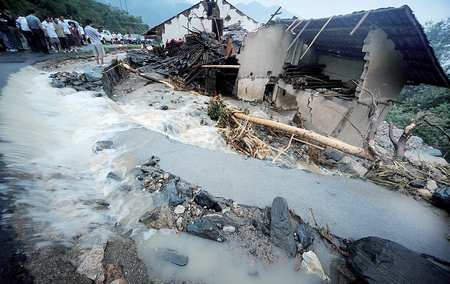Flood deaths could top 1,000
Meteorologists said the worst floods since 2000 are raging through a large swath of the country, and direct economic losses are mounting.
The rainfall is unprecedented in some areas, and warnings have been issued to the country's conservation facilities.
 |
|
Residents stand close to collapsed houses in Yiling district in Wuchang, Central China's Hubei Province, on Saturday. Flash floods triggered by torrential rains are wreaking havoc in the area, cutting off transportation, bringing down houses and destroying cropland.[CFP] |
Floods have claimed at least 742 lives and left 367 missing since the beginning of this year, the State Flood Control and Drought Relief Headquarters said on its website Friday.
Meanwhile, a total of 28 provinces and municipalities were stricken by floods, with 120 million people and more than 7 million hectares of crops affected. More than 670,000 houses have collapsed, leading to direct economic losses of 152.4 billion yuan (US$22.48 billion).
Chinese Premier Wen Jiabao urged local authorities Saturday to be fully aware of the "grave flood-control situation" and to prepare for more serious flooding of the Huaihe River, the sixth-longest waterway in China, according to the Xinhua News Agency.
The extensive rainfalls along the Huaihe River in July have made the water level exceed the warning line, causing serious waterlogging in areas along the river. Although water levels have dropped in recent days, weather forecasters are predicting more heavy rain along the river and areas to its south today and Tuesday.
In Northwest Shaanxi Province, a landslide hit Ningqiang County, Hanzhong City, Sunday, but no casualties have yet been reported.
The landslide, triggered by torrential rains, struck Shujiaba Township of Ningqiang County around 8:30 am, according to township head Yang Qingquan.
Workers with the township government had evacuated about 300 residents from two villages, moving the people to safety, Yang said.
About 100,000 cubic meters of debris blocked a local river and formed a lake, but the water level of the lake had begun falling, he said.
In Sichuan Province, a 13-hour rainstorm Saturday night hit Chengdu Shuangliu Airport, delaying flights, resulting in a record 645 flights taking off Sunday, the most crowded day since the airport started operating. More than 9,000 passengers have been affected and were staying in the airport Sunday, waiting for their flights to take off.
Cause hard to pinpoint
Zhang Mingying, with the Beijing Meteorological Bureau, told the Global Times that the rainstorms in the southern and northern parts of China are caused by various factors.
The south, including Guangdong Province, is mainly affected by typhoons, while in Shaanxi, storms called eddys are the main cause of the rain. And northeastern provinces such as Liaoning and Jilin provinces are affected by low-pressure cyclones.
However, Zhang noted that one common reason for the storms is the influence of warm and humid subtropical highs, which provide sufficient vapor. And the phenomenon is not surprising in summer.
China's State flood control authorities say there will be a total of six to eight typhoons that reach land and affect China this year. The typhoons in the later part of the year could be more intense and powerful. They may also land further north and trigger severe flood disasters, according to Xinhua.
The rainfall this year features a concentration in certain areas, which is rare in climatic history and reveals shortcomings of our water conservancy facilities because those facilities were designed according to climate information of the area, Zhang said.
"The Three Gorges Dam project made a great contribution to flood control," he added. "But water-conservancy facilities should always be reinforced so we can better prevent disasters."
Fierce temperatures
The Beijing Meteorological Bureau released Sunday a high-temperature warning, predicting temperatures from today through Wednesday would stay above 35 C. At the start of July, Beijing suffered in high temperatures around 40 C, and the hot weather has returned after several rainfalls.
Other regions including the Ningxia Hui Autonomous Region, Xinjiang Uyghur Autonomous Region, and Inner Mongolia Autonomous Region and Sichuan Province, will face temperatures above 35 C in the next three days as well, with some regions reaching 40 C, according to weather forecasts.
Scorching sunshine seems to have discouraged people from outdoor activities. Liu Kaiping, a kindergarten teacher in Chongqing, told the Global Times that he dare not go outside during the day because the temperature reached 38 or 39 C.
"There are not many people in the street because of the hot weather," he said. "And we have to turn on the air conditioners for the whole day."
 0
0 







Go to Forum >>0 Comments